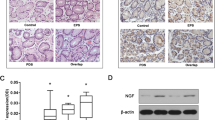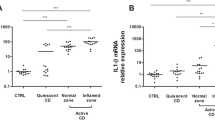Abstract
Background
In patients with functional dyspepsia (FD), mild duodenal inflammation correlates with increased mucosal permeability. Enteric glial cells can produce glial cell line-derived neurotrophic factor (GDNF) to repair disrupted epithelial barrier function.
Aims
We examined the role of duodenal GDNF in FD pathophysiology and its association with dyspeptic symptoms.
Methods
Duodenal biopsies taken from FD patients and control subjects were used for analysis. GDNF protein expression and localization were examined. Cellular infiltration of eosinophils and mast cells was measured. We also examined the intercellular space between the adjacent epithelial cells at the apical junction complex using transmission electron microscopy.
Results
In FD patients, expression of GDNF protein was significantly increased compared with controls, 107.3 (95.3–136.7) versus 49.3 (38.0–72.6) pg/mg protein (median (interquartile range), p = 0.006), respectively. GDNF was localized in enteric glial cells, eosinophils, and epithelial cells. The number of eosinophils was significantly greater in FD patients than in controls, 1039 (923–1181) versus 553 (479–598) cells/mm2 (p = 0.021), respectively. The intercellular space was dilated at the adherent junction in FD patients compared to control patients, 32.4 (29.8–34.8) versus 22.0 (19.9–26.1) nm (p = 0.002), respectively. Intercellular distance positively correlated with the frequency of postprandial fullness and early satiation (p = 0.001, r = 0.837 and p = 0.009, r = 0.693, respectively). Expression of GDNF correlated with epigastric burning (p = 0.041, r = 0.552).
Conclusions
Increased expression of duodenal GDNF might be involved in FD pathophysiology and symptom perception.





Similar content being viewed by others
References
Tominaga K, Higuchi K, Ochi M, et al. Concurrent assessment of reservoir and emptying of the stomach for dyspepsia patients. Hepatogastroenterology. 2008;55:744–749.
Tominaga K, Arakawa T. Kampo medicines for gastrointestinal tract disorders: a review of basic science and clinical evidence and their future application. J Gastroenterol. 2013;48:452–462.
Salet GA, Samsom M, Roelofs JM, van Berge Henegouwen GP, Smout AJ, Akkermans LM. Responses to gastric distension in functional dyspepsia. Gut. 1998;42:823–829.
Tominaga K, Higuchi K, Iketani T, et al. Comparison of gastrointestinal symptoms and psychological factors of functional dyspepsia to peptic ulcer or panic disorder patients. Inflammopharmacology. 2007;15:84–89.
Ochi M, Tominaga K, Iketani T, et al. Perfectionism underlying psychological background correlated with the symptoms of functional dyspepsia. J Gastroenterol. 2008;43:699–704.
Tominaga K, Fujikawa Y, Tsumoto C, et al. Disorder of autonomic nervous system and its vulnerability to external stimulation in functional dyspepsia. J Clin Biochem Nutr. 2016;58:161–165.
Tominaga K, Tsumoto C, Ataka S, et al. Regional brain disorders of serotonin neurotransmission are associated with functional dyspepsia. Life Sci. 2015;137:150–157.
Tack J, Talley NJ, Camilleri M, et al. Functional gastroduodenal disorders. Gastroenterology. 2006;130:1466–1479.
Piche T, Barbara G, Aubert P, et al. Impaired intestinal barrier integrity in the colon of patients with irritable bowel syndrome: involvement of soluble mediators. Gut. 2009;58:196–201.
Martínez C, Lobo B, Pigrau M, et al. Diarrhoea-predominant irritable bowel syndrome: an organic disorder with structural abnormalities in the jejunal epithelial barrier. Gut. 2013;62:1160–1168.
Vanheel H, Vicario M, Vanuytsel T, et al. Impaired duodenal mucosal integrity and low-grade inflammation in functional dyspepsia. Gut. 2014;63:262–271.
Cirillo C, Bessissow T, Desmet AS, Vanheel H, Tack J, Vanden Berghe P. Evidence for neuronal and structural changes in submucous ganglia of patients with functional dyspepsia. Am J Gastroenterol. 2015;110:1205–1215.
Neunlist M, Van Landeghem L, Mahé MM, Derkinderen P, des Varannes SB, Rolli-Derkinderen M. The digestive neuronal-glial-epithelial unit: a new actor in gut health and disease. Nat Rev Gastroenterol Hepatol. 2013;10:90–100.
Fujikawa Y, Tominaga K, Tanaka F, et al. Enteric glial cells are associated with stress-induced colonic hyper-contraction in maternally separated rats. Neurogastroenterol Motil. 2015;27:1010–1023.
Tominaga K, Fujikawa Y, Tanaka F, et al. Structural changes in gastric glial cells and delayed gastric emptying as responses to early life stress and acute adulthood stress in rats. Life Sci. 2016;148:254–259.
Zhang DK, He FQ, Li TK, et al. Glial-derived neurotrophic factor regulates intestinal epithelial barrier function and inflammation and is therapeutic for murine colitis. J Pathol. 2010;222:213–222.
Schneider CA, Rasband WS, Eliceiri KW. NIH Image to ImageJ: 25 years of image analysis. Nat Methods. 2012;9:671–675.
Steinkamp M, Gundel H, Schulte N, et al. GDNF protects enteric glia from apoptosis: evidence for an autocrine loop. BMC Gastroenterol. 2012;12:6.
Meir M, Flemming S, Burkard N, et al. Glial cell line-derived neurotrophic factor (GDNF) promotes barrier maturation and wound healing in intestinal epithelial cells in vitro. Am J Physiol Gastrointest Liver Physiol. 2015;309:G613–G624.
Talley NJ, Walker MM, Aro P, et al. Non-ulcer dyspepsia and duodenal eosinophilia: an adult endoscopic population-based case-control study. Clin Gastroenterol Hepatol. 2007;5:1175–1183.
Ochi M, Tominaga K, Tanaka F, et al. Clinical classification of subgroups according to the Rome III criteria cannot be used to distinguish the associated respective pathophysiology in Japanese patients with functional dyspepsia. Intern Med. 2013;52:1289–1293.
Walker MM, Talley NJ, Prabhakar M, et al. Duodenal mastocytosis, eosinophilia and intraepithelial lymphocytosis as possible disease markers in the irritable bowel syndrome and functional dyspepsia. Aliment Pharmacol Ther. 2009;29:765–773.
Acknowledgments
TEM experiments were performed in the Central Laboratory of Osaka City University Medical School. We thank Mr. Hideki Nakagawa for technical support.
Funding
This work was supported by JSPS KAKENHI Grant Number JP24790659.
Author information
Authors and Affiliations
Corresponding author
Ethics declarations
Conflict of interest
Tetsuo Arakawa has participated in advisory committees for Otsuka Pharmaceutical Co. Ltd. and Eisai Co. Ltd. Yasuhiro Fujiwara has participated in advisory committees for Eisai Co. Ltd. All other authors declare that they have no conflicts of interest.
Rights and permissions
About this article
Cite this article
Tanaka, F., Tominaga, K., Fujikawa, Y. et al. Concentration of Glial Cell Line-Derived Neurotrophic Factor Positively Correlates with Symptoms in Functional Dyspepsia. Dig Dis Sci 61, 3478–3485 (2016). https://doi.org/10.1007/s10620-016-4329-5
Received:
Accepted:
Published:
Issue Date:
DOI: https://doi.org/10.1007/s10620-016-4329-5




